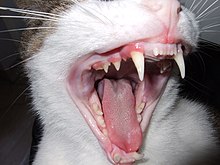Hugo Triadan
Hugo Triadan (born October 3, 1930 in Basel , † October 11, 1987 in Bern ) was a Swiss dentist and professor at the Medical University of Hanover and headed the clinic for tooth preservation , periodontology and preventive dentistry . He developed a world-wide applied tooth scheme for animals.
Life
After studying dentistry at the University of Basel , the Christian-Albrechts-Universität zu Kiel and the University of Bern , Triadan received his doctorate in 1959. med. dent. in Basel. He practiced as a dentist in Laufen in the canton of Basel-Landschaft (formerly canton Bern). This was followed by an assistantship in Kiel before he became senior assistant in Bern. In 1966 he completed his habilitation in dentistry with the text “About the periodontal side effects of chronic hydantoin treatment” in Bern. In 1971 he became a. o. Professor appointed.
Dental scheme according to Triadan
In 1972 he developed a dental scheme for animals that has been used worldwide since then. In doing so, he was based on the FDI human tooth scheme , which was developed in 1960 by the Berlin university professor Joachim Viohl .
A quadrant is one half of the jaw. The dentition thus consists of four quadrants. In the FDI scheme, the quadrant number is placed in front of the code number of the tooth. The quadrants are numbered counterclockwise from the patient's point of view, starting with the upper jaw on the right. The teeth, in turn, are numbered from the center backwards. The upper right canine is labeled with the code number “13”. The "1" stands for the upper right quadrant, the "3" for the third tooth calculated from the middle. The lower left first premolar is given the code number "34". The deciduous tooth quadrants are numbered accordingly from 5 to 8,
In the Triadan tooth scheme - to differentiate it from the FDI tooth scheme of humans - the tooth numbers are counted from the middle towards the throat starting with a "0" after the quadrant numbers. It is also called the three-digit system. Accordingly, the upper right first incisor is named "101" (one - zero - one), the lower left canine ( canine ) is named "304" (three - zero - four).
- example
| Permanent cat teeth | |||||||||||||||
|---|---|---|---|---|---|---|---|---|---|---|---|---|---|---|---|
| top right | top left | ||||||||||||||
| 108 | 107 | 106 | 105 | 104 | 103 | 102 | 101 | 201 | 202 | 203 | 204 | 205 | 206 | 207 | 208 |
| 407 | 406 | 405 | 404 | 403 | 402 | 401 | 301 | 302 | 303 | 304 | 305 | 306 | 307 | ||
| bottom right | bottom left | ||||||||||||||
| Baby teeth (cat) | |||||||||||||||
| top right | top left | ||||||||||||||
| 507 | 506 | 505 | 504 | 503 | 502 | 501 | 601 | 602 | 603 | 604 | 605 | 606 | 607 | ||
| 806 | 805 | 804 | 803 | 802 | 801 | 701 | 702 | 703 | 704 | 705 | 706 | ||||
| bottom right | bottom left | ||||||||||||||
( Incisors , canini , premolars , molars ).
Triadan received in 1973 a reputation for o. Professor at the Hannover Medical School, where he became head of the Department of Conservative Dentistry, Periodontology and Preventive Dentistry. Triadan also worked on preventive dentistry in animals at the University of Veterinary Medicine Hannover .
Honors
- Award of an honorary doctorate
Individual evidence
- ^ Hugo Triaden, On the periodontal side effects of chronic hydantoin treatment , HEIDI - University Library Heidelberg University. Retrieved June 22, 2015.
- ↑ Biogram Triadan, Hugo ( Memento of the original from June 21, 2015 in the Internet Archive ) Info: The archive link was inserted automatically and has not yet been checked. Please check the original and archive link according to the instructions and then remove this notice. , Free University of Berlin , Department of Veterinary Medicine. Retrieved June 21, 2015.
- ↑ Ekkehard Finkeissen: Dental Decision Making . BoD - Books on Demand, August 2002, ISBN 978-3-8311-4198-2 , p. 251.
- ^ MR Floyd: The modified Triadan system: nomenclature for veterinary dentistry. In: Journal of veterinary dentistry. Volume 8, Number 4, December 1991, ISSN 0898-7564 , pp. 18-19, PMID 1815632 .
- ↑ Markus Eickhoff: Dentistry, oral medicine and maxillofacial medicine for small and domestic animals . Georg Thieme Verlag, 2005, ISBN 978-3-8304-1038-6 , p. 10.
- ↑ Olof Dietz: Handbook horse practice . Georg Thieme Verlag, 2006, ISBN 978-3-8304-1028-7 , p. 380.
| personal data | |
|---|---|
| SURNAME | Triadan, Hugo |
| BRIEF DESCRIPTION | Swiss dentist and university professor |
| DATE OF BIRTH | October 3, 1930 |
| PLACE OF BIRTH | Basel |
| DATE OF DEATH | October 11, 1987 |
| Place of death | Bern |
